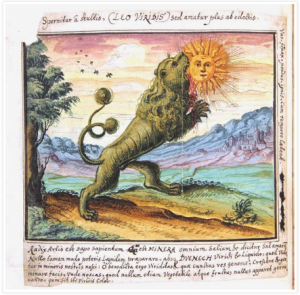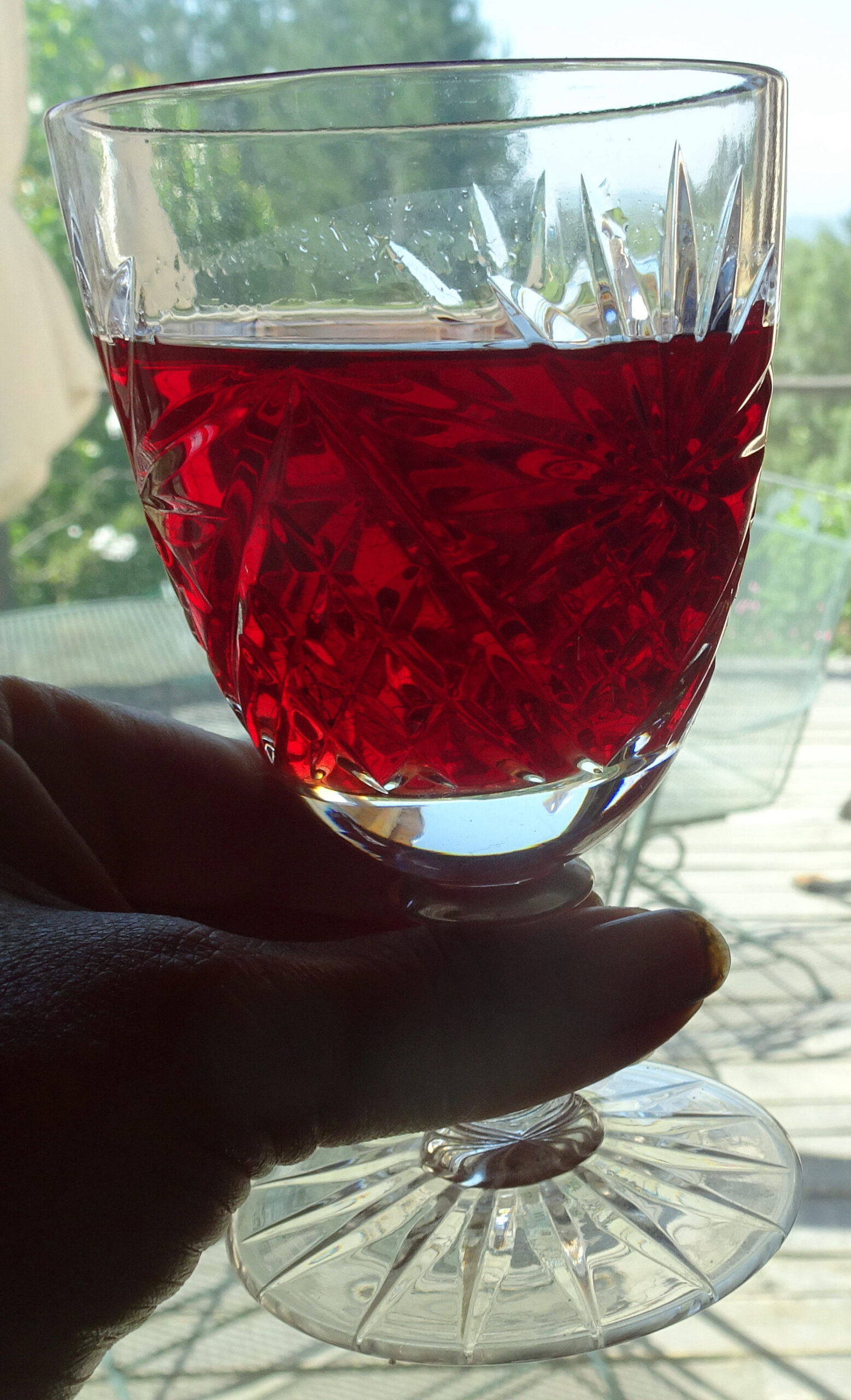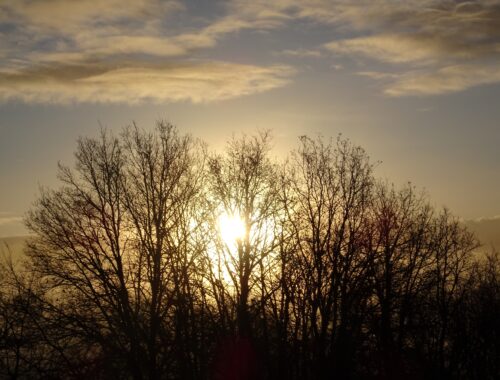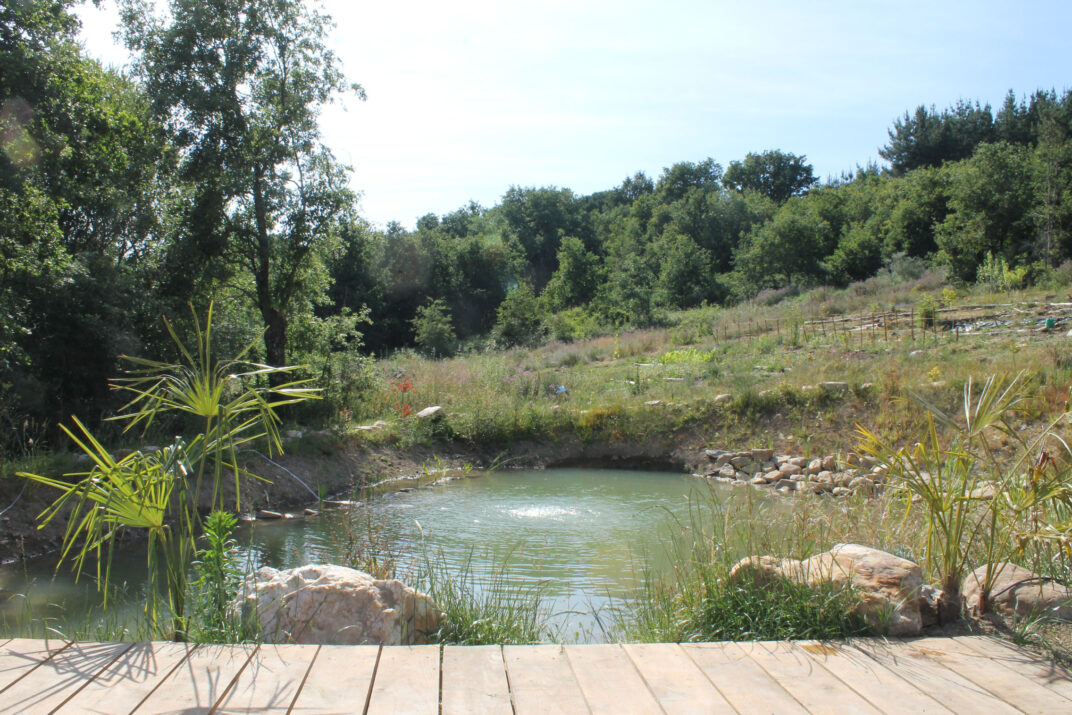
Wild Juicing
Foraging for weeds
Whatever the weather, our day starts with walking the dogs and (sometimes with cats in tow) and sometimes foraging for weeds. We are lucky to live in an area where there is no intensive farming, no crop spraying and lots of hedgerows, meadows and verges, where the wild plants flourish. Our own land was not occupied for 40 years before we moved here so, although it is hard work clawing out a few patches for cultivation, at least I know that our soil is relatively uncontaminated. In the height of summer, when it can be very hot and dry, there’s not usually so much to be had from the wild, but we usually have plenty in our garden then. Foraging and wild juicing is more of a spring and winter activity for us.
I started juicing two years ago in spring when the cleavers came out en masse and almost begged to be juiced. I bought a Lexen Manual Juicer, as the electric one some one left us is so big and noisy and I have Luddite leanings. What a joy this little machine is. It makes beautiful, rich and slick juice and is so satisfying to use – and easy to clean. I much prefer it to the electric version. Chopping the plants and fruits and pushing them into the machine and watching the juice and pulp come out is a kind of meditation.
Wild juice ingredients
Wild juice recipe
- 2-3 crisp apples
- 3 sticks of celery
- Large thumb-sized piece of ginger
- Handful of coriander/cilantro leaves
And several handfuls of one or more of the following:
- Beetroot
- Bok choy
- Broccoli leaves
- Cabbage (red or green)
- Carrots
- Chickweed
- Cleavers
- Coriander/cilantro
- Dandelion leaves
- Kale
- Lemon balm (not too much as it’s very strong)
- Mallow (not too much as it’s very gooey)
- Milk thistle leaves
- Parsley
- Plantain leaves
- Radish leaves –
- Red Clover
- Swiss chard
- Wheat grass
- Yarrow (not too much as it’s pucker-power astringent)
For our tastes the apple, celery, ginger and coriander/cilantro is the basic blend and then whatever greens are available. This juicer prefers hard fruits, technically it’s a wheat grass juicer, so anything too mushy doesn’t work so well. We grow broccoli, kale, swiss chard and cabbage for most of the year, hopefully the ginger, coriander/cilantro and apples will make it this year and we find the ‘weeds’ on our walks.
Biological power plants
The human body is a biological power plant, as it transduces multiple energy sources for different systems and processes. Oxygen is used as the primary fuel to break down food, carbohydrates, fats, minerals and vitamins in order to power movement and essential physiological processes, such as digestion, respiration, mitosis and repair. The nervous system is considered to be primarily electrical, driven by the polarizing actions of the sodium-potassium pump in response to stimuli and then back to the resting state after external stimulation. The nervous system uses about one third of the body’s overall energy capacity, regardless of physical activity or lifestyle choices. Except in cases of injury, poisoning or chronic illness, most ‘nervous conditions’ can be significantly remediated through diet. However, more recently some researchers are considering that the nervous system is powered by light. And what about the senses????
The human body also creates energy. I cranked my manual juicer with kinetic energy, not hard enough to make me sweat (thankfully), but just being alive creates thermal energy. And then there is light. All life forms radiate light, which is electromagnetic energy. Some electromagnetic energy is visible to the naked eye, like rainbows or laser beams, but most isn’t.
Your body grows new retinal cells every two days, new skin in six weeks, a new liver over an eight week period and new nerve cells in a matter of months. So what stops us from regenerating and why do we all show signs of ageing, with advancing years? Those are big questions, with many answers, but in biological terms your body needs three things:
- the right raw materials from which to construct new cells;
- sufficient cellular energy to enable it to use the raw materials;
- a working communication system, so it knows what to do and when;
- a guiding narrative that attunes you to health and regeneration.
If any one of these three components is depleted, as they mostly are, you don’t heal and regenerate as you were designed to do and eventually you succumb to total systemic failure – otherwise known as death. Additionally, cells, systems, habits and even civilizations all go through a natural process of apoptosis, signified by chaos, and that’s one way of looking at the current conditions. The question is: what do you do about it? You can just find yourself a safe haven and ride out the rest of you life as best you can and there’s plenty to be said for that approach, I nearly ended up there myself. But funnily enough, when I found my safe haven, here in Galicia, I began to perceive and experience life in a very different way. Life gushes, sprouts and oozes through every pore in the earth and atmosphere here and I want more of it. This leads back to the plants, the wild plants and weeds……
Have you ever stopped to consider why you need to put so much time and effort into weeding the garden? The weeds always win! They are stronger, better adapted to the environment and they are prolific, whatever the conditions, the weeds survive and return more quickly than cultivated plants – they are the power plants. That’s because they grow as Nature intended, they haven’t been hybridized for yield benefits or so they can be transported over long distances, irradiated and still look tasty on a grocery store shelf. Domestic vegetables are designed for profit and wild plants are designed for life. Wild plants contain at least 5 – 10 times more nutrients, vitamins, enzymes, phytochemicals and biophotons than supermarket vegetables. 15 grams of nettles contain far more nutrients than 100 grams of healthy romaine lettuce. I’ve long suspected that one of the reasons I didn’t do well on a vegetarian diet was lack of minerals. I’m very reluctant to use supplements, as I regard them as suspiciously as I do every other processed ‘food – made for profit, rather than health. Several studies have shown that the mineral content of wild edible plants is higher than their commercial equivalents, which stands to reason if the wild plants are collected from soil that has not been depleted through industrial farming methods. However, there is another reason, that is even more significant and that is light.
Eat light!
Biophotons, that is light emitted by life, were discovered in 1923 by Russian scientist Professor Alexander Gurvich, who originally named them “mitogenetic rays”. German biophysicist Fritz-Albert Popp proved their existence in 1974 and subsequently developed biophoton theory based on observation to explain their possible biological role and the ways in which they may control biochemical processes, growth, differentiation etc. This work is now continued in a network of research laboratories in more than 10 countries, although it remains outside of make-believe mainstream science.
The radiant light emanating from animals and plants that is too faint to be seen by the naked eye. It would be like seeing a lit candle in the dark from 20km away, but it has been repeatedly photographed using the Popp designed photomultiplier devices. In humans it appears to be most concentrated in the forehead, the throat and the chest area.
According to Popp, living cells and DNA use electromagnetic waves to communicate and transfer information. Substances and unnatural electromagnetic fields, disrupt the natural cycles of light emission causing loss of coherence and poor intracellular communication, so that the body is unable to generate new healthy cells. For example, Popp found that cancer cells were not attuned to the rest of the body ie. out of synch, dancing to a different tune.
A biophoton is always emitted before each of the appproximately 100,000 biochemical reactions that occur per second in every cell in the human body. There is no biochemical reaction that takes place without the preceding biophoton signal, which is why it is considered to be the ‘steering system’ for all the biochemistry that takes place in the body. The communication system of the body is more akin to fibre optics than copper wires.
If you can find a very local source of edible wild plants, give wild juicing a try and I’m sure you’ll notice the benefits in a few weeks. Popp considers the biophoton content to be of far greater importance than just the nutrient or caloric content of a food freshly picked, as it brings coherence back into the body. Health and regeneration is just not possible without communication and coherence. Eating plants with a high biophoton content helps correct the deficit caused by electromagnetic pollution and reconnects you with nature – another part of the story. Wild edible leafy green plants have the highest biophoton content of all foods available, as the ancient alchemists surely knew.

Microbes
There are said to be around 100 trillion microbes in the gut, bacteria, fungi and protozoa and they are part of the digestive process. Essentially, they break down different foods in various ways, by providing enzymes that the body does not produce itself. A healthy microbiota (community of microbes) results in good health and an optimized immune system. Conversely, lack of microbial diversity in the gut has been implicated in many conditions, such as arthritis, diabetes, eczema, heart disease and obesity.
The microbiota is adversely affected by sugar substitutes, such as aspartame and sucralose and saccharin, medications and antibiotics and food additives in processed foods. However, it will recover quickly when these are stopped and natural wholesome foods are introduced back into the diet.
I take the view that the microbes in my body and those in the environment act as one super-organism and are in continuous communication with each other. So eating local wild foods enhances my connection with nature and supports my intuition and regeneration (which depends on signals from the environment), as well as my health.
Magnetic Intent
You May Also Like

St John’s Wort: Blood from the Sun
August 4, 2021
Melissa: Queen of the Bee Haven
January 23, 2020

